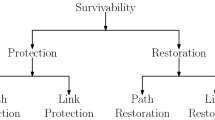Abstract
Many researchers have proposed restoration techniques incorporating the concept of k-shortest disjoint paths in survivable WDM (Wavelength Division Multiplexing) optical networks, but without considering network performance and network costs simultaneously. In this paper we need to carefully look into how well the concept of shortest disjoint paths is incorporated for given objective functions. Seven objective functions and four algorithms are presented to evaluate the concept of k-shortest disjoint paths for the design of a robust WDM optical network. A case study based on simulation experiments is conducted to illustrate the application and efficiency of k-shortest disjoint paths in terms of following objective goals: minimal wavelengths, minimal wavelength link distance, minimal wavelength mileage costs, even distribution of traffic flows, average restoration time of backup lightpaths, and physical topology constraints.
Similar content being viewed by others
References
C. Assi, Y. Ye, A. Shami, S. Dixit and M. Ali, Efficient path selection and fast restoration algorithms for shared restorable optical networks, in: Proceedings of ICC (Anchorage, Alaska, 2003), pp. 1412–1416.
A. Dacomo, S. Patre, G. Maier, A. Pattavina and M. Martinelli, Design of static resilient WDM mesh networks with multiple heuristic criteria, in: Proceedings of IEEE INFOCOM (New York, 2002), pp. 1793–1802.
H. Luo and L. Ruan, Load balancing heuristics for dynamic establishment of restorable lightpaths, in: Proceedings of ICCN (Miami, Florida, 2002), pp. 472–477.
E. Modiano and T.A. Narula, Survivable lightpath routing: A new approach to the design of WDM-based networks, IEEE Journal on Selected Areas in Communications 20(4) (2002) 800–809.
P.H. Ho and H. Mouftah, A framework for service-guaranteed shared protection in WDM mesh networks, IEEE Communication Magazine 40(2) (2002) 97–103.
S. Sengupta and R. Ramamurthy, From network design to dynamic provisioning and restoration in optical cross-connect mesh networks: An architectural and algorithmic overview, IEEE Network 15(4) (2001) 46–54.
D. Banerjee and B. Mukerjee, Wavelength-routed optical networks: linear formulation, resource budgeting tradeoffs, and a reconfiguration study, IEEE/ACM Transactions on Networking 8(5) (2000) 598–607.
S. Lumetta, M. Medard and Y.C. Tseng, Capacity versus robustness: A tradeoff for link restoration in mesh networks, IEEE Journal of Lightwave Technology 18(12) (2000) 1765–1775.
B. Mukherjee, S. Ramamurthy, D. Banerjee and A. Mukerjee, Some principles for designing a wide-area WDM optical networks, IEEE/ACM Transactions on Networking 4(5) (1996) 684–696.
R. Ramaswami and K. Sivarajan, Design of logical topologies for wavelength-routed optical networks, IEEE Journal on Selected Areas in Communications 14(5) (1996) 840–851.
D. Dunn, W. Grover and M. Gregor, Comparison of k-shortest paths and maximum flow routing for network facility restoration, IEEE Journal on Selected Areas in Communications 12(1) (1994) 88–89.
R. Bhandari, Optimal diverse routing in telecommunication fiber networks, in: Proceedings of IEEE INFOCOM (Tronto, Ontario, 1994), pp. 1498–1508.
I.H. Osman and G. Laporte, Metaheuristic: A bibliography, Anneals of Operations Research 63 (1996) 513–538.
K.C. Claffy, G.C. Polyzos and H.W. Braun, Traffic characteristics of the NSFNET backbone, in: Proceedings of IEEE INFOCOM (San Francisco, CA, 1993), pp. 885–892.
S. Tak and E.K. Park, Some principles of dependencies between physical topology and virtual topology for efficient restoration of WDM optical networks, in: Proceedings of International Conference on Photonics in Switching (2002), pp. 22–24.
A. Liebers, Planarizing graphs–a survey and annotated bibliography, Journal of Graph Algorithms and Applications 5 (2001) 1–74.
J. Sosnosky, Service applications for SONET DCS distributed restoration, IEEE Journal on Selected Areas in Communications 12(1) (1994) 59–68.
Author information
Authors and Affiliations
Corresponding author
Additional information
Sungwoo Takis an assistant professor in the Department of Computer Science and Engineering at Pusan National University. He is also a research member at Research Institute of Computer Information and Communication at Pusan National University. He received a Ph.D. degree in Computer Science from the University of Missouri Kansas City. He has served as a TPC member for the IEEE ICCCN (International Conference on Computer Communications and Networks) since 2004. His research interests include Computer Networks, Wireless Networks, Software Architecture, WDM Optical Networks, Real-time Systems, and SoC (System on Chips) based Communication Chip Design.
E. K. Park is a Professor of Computer Science at the University of Missouri at Kansas City. He received a Ph.D. degree in Computer Science from the Northwestern University. His research interests include software engineering, software architectures, software agents, distributed systems, object-oriented methodology, software tolerance and reliability, computer networks and management, optical networks, database/data mining, and information/knowledge management.
Rights and permissions
About this article
Cite this article
Tak, S., Park, E.K. Restoration performance study of k-shortest disjoint paths in WDM optical networks. Telecommun Syst 34, 13–26 (2007). https://doi.org/10.1007/s11235-006-9026-9
Received:
Revised:
Accepted:
Published:
Issue Date:
DOI: https://doi.org/10.1007/s11235-006-9026-9




